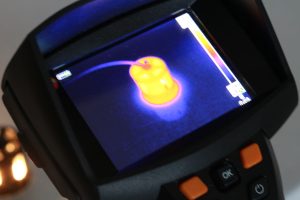Where is the heat coming from?
Whilst LEDs are highly efficient, there is still an amount of electrical power that is converted to heat, not just light. LED overheating can be caused by many rather obvious design factors such as inadequate heat sinking and excess LED power. But a well-designed LED luminaire can be equally overheated by installing it in an environment for which it was not designed. To get the very best performance from the LEDs the excess heat needs to be conducted away from the LEDs – to avoid exceeding the recommended maximum operating temperatures. With as much as a 10% decrease in light output being attributed to temperature increases, getting your thermals in check when designing your LED solution is a must.

Effective thermal management is fundamental to the design process of an LED solution. We need to understand the application – any space limitations, the environment of the installation and power requirements can have an impact on heat dissipation. We also need to understand the performance, cost and efficiency targets to allow for an effective design that achieves an LED solution, that does what you want it to.
What damage can heat cause?
LEDs that overheat will degrade more rapidly in terms of:
In extreme cases overheating LEDs can result in physical damage to the LEDs themselves, plastic lenses, wires, connectors, printed circuit boards, drive electronics etc.
How to get your thermals sorted
Thermal design is intrinsic to every element of design including LED selection, PCB design and layout, and electronics design. When choosing the LED; the power, LED junction temperature and thermal resistance are all considered and compared.
The design and layout of the PCB is another way to conduct heat away from the LED. PCB materials have varying thermal characteristics, enlarged solder pads and thicker copper layers help to distribute the heat across the PCB. The addition of thermal vias – drilling holes and copper plating them - can also improve the thermal resistance of FR4.
Design with thermal simulations
A heatsink transfers the generated heat from the LED board to the ambient air using convection and radiation. When we design heatsinks our aim is to optimize airflow and improve the thermal efficiency of the complete LED solution.
Using the latest in Computational Fluid Dynamics (CFD) Software we can easily simulate and analyse various heatsink designs to optimise thermal efficiency. With the ability to visualise airflow, calculate thermal resistance and model the application environment our engineers can very quickly evaluate designs, and even make tweaks to improve the thermal efficiency before moving into prototyping. This allows us to very quickly get to prototyping and production with a solution that works – we’ll also test to ensure that the solution runs to our simulations and predictions.

